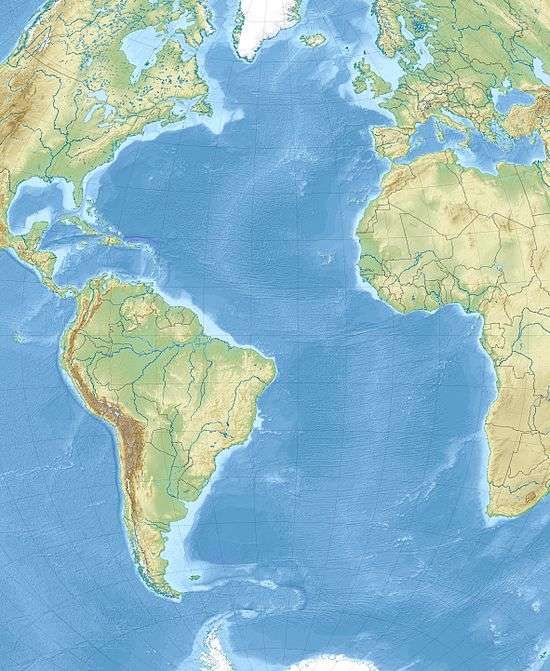2007 Iberian Peninsula earthquake
 | |
| UTC time | ?? |
|---|---|
| ISC event | |
| USGS-ANSS | |
| Date * | February 12, 2007 |
| Origin time * | 10:35:31 UTC [1] |
| Local date | |
| Local time | |
| Magnitude | 6.1 Mw [1] |
| Depth | 45 km (28 mi) [1] |
| Epicenter | 35°27′N 9°56′W / 35.45°N 9.94°WCoordinates: 35°27′N 9°56′W / 35.45°N 9.94°W [1] |
| Type | Oblique-slip [2] |
| Max. intensity | IV (Largely observed) [1] |
| Peak acceleration | .0001321g [3] |
| Tsunami | No |
| * Deprecated | See documentation. |
The 2007 Iberian Peninsula earthquake (also known as the 2007 Horseshoe earthquake) occurred at 10:35:31 Greenwich Mean Time on February 12 with its epicentre in the eastern Atlantic Ocean, off the coasts of Portugal and Morocco. The earthquake had a moment magnitude of 6.1 and a maximum intensity of IV (Largely observed) on the European macroseismic scale. The shock occurred at a plate boundary where a number of large, very large, and great earthquakes are known to have taken place as far back as the eighteenth-century. The event was captured by a network of strong motion instruments in Spain, but due to the distance at which the shock was recorded, the peak ground acceleration was very low.
Tectonic setting
On its west, south, and east sides the African Plate is surrounded by spreading centers, and on the north side, the plate forms a convergent boundary with the Eurasian Plate in the central and eastern Mediterranean Sea. At the extreme northwestern boundary of the plate lies the Azores Triple Junction, where the Mid-Atlantic Ridge meets the right-lateral strike-slip Azores–Gibraltar Transform Fault, which is an east–west trending structure that continues toward the Strait of Gibraltar as the Gloria Fault.[4]
Earthquake
The undersea earthquake occurred about 175 kilometres (109 mi) from the southwest coast of Portugal in the eastern Horseshoe Abyssal Plain, a geological feature that was the same location of the 1969 Portugal earthquake. The shock was widely felt in Portugal, Spain, and Morocco, but did not cause any damage due to its distance from the shore, and was followed by four small aftershocks of M3.5 or less.[5]
Intensity
In Morocco, intensities for the event were up to IV (Largely observed) in the coastal cities of Tangier, Rabat, Casablanca, El Jadida and Safi. Slightly higher intensities were reported in the taller buildings in Casablanca. Intensities were about II (Scarcely felt) in the much more distant cities of Agadir, Ouarzazet, Errachidia, and Taza. Some of these towns were up to 650 kilometres (400 mi) away. The depth of the event was listed as one reason why the shock was felt over such a wide area.[1]
Strong motion
The Instituto Geográfico Nacional operates a network of strong motion instruments in Spain. Eight accelerometers recorded the event at distances between 326–623 kilometres (203–387 mi). The three nearest stations (Cartaya, Huelva, and Matalascañas) were on relatively soft soil and recorded the highest ground motion. The station at Cartaya saw a peak ground acceleration of .0001321g.[3]
See also
References
- 1 2 3 4 5 6 Jabour, N.; Hahou, Y.; Benchekroun, S.; Timoulali, Y.; Menzhi, M.; Hni, L.; Badrane, S.; Kasmi, M.; Birouk, A. (2007), The Cape St. Vincent Earthquake of February 12, 2007 Macroseismic effects, CSEM/EMSC Newsletter, European-Mediterranean Seismological Centre
- ↑ Stich, D.; de Lis Mancilla, F.; Pondrelli, S.; Morales, J. (2007), "Source analysis of the February 12th 2007, Mw 6.0 Horseshoe earthquake: Implications for the 1755 Lisbon earthquake", Geophysical Research Letters, American Geophysical Union, 34 (12): 12308, Bibcode:2007GeoRL..3412308S, doi:10.1029/2007GL030012
- 1 2 Cabañas, L.; Martin, A.J.; Alcalde, J.M. (2007), Recorded ground accelerations in the 2007/02/12 SW Cape St. Vincent Earthquake, CSEM/EMSC Newsletter, European-Mediterranean Seismological Centre
- ↑ Yeats, R. (2012), Active Faults of the World, Cambridge University Press, pp. 225, 237–239, ISBN 978-0-521-19085-5
- ↑ Borges, J.F.; Bezzeghoud, M.; Caldeira, B.; van Eck, T. (2007), The recent 2007 Portugal earthquake (Mw=6.1) in the seismotectonic context of the SW Atlantic area, CSEM/EMSC Newsletter, European-Mediterranean Seismological Centre
External links
- Event page – Broadband Seismic Data Collection Center
- M6.0 - Azores-Cape St. Vincent Ridge – United States Geological Survey
- The International Seismological Centre has a bibliography and/or authoritative data for this event.